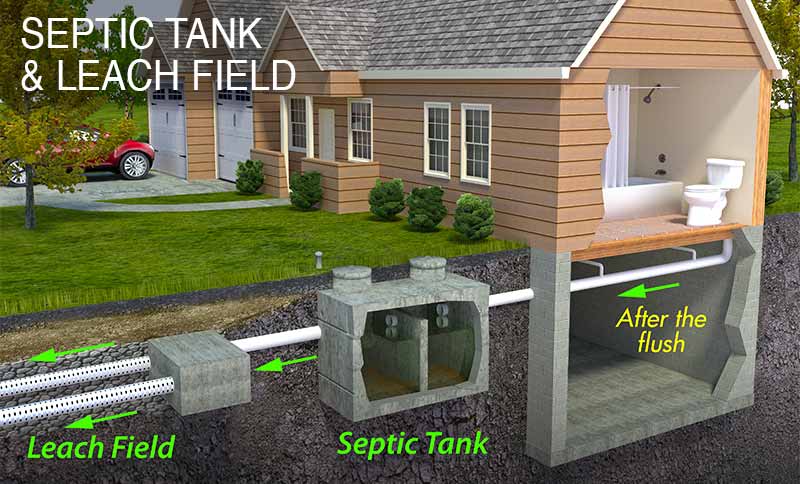If you have a septic system, knowing the distance between the septic tank and the leach field (also called a drain field) is important for maintenance and protecting your system. The leach field is the underground area where wastewater from the septic tank is discharged and absorbed into the soil.
Understanding where your leach field is in relation to the septic tank allows you to avoid damaging this vital part of your septic system. Read on to learn about typical distances between the septic tank and leach field, plus steps to locate your system components.
What is the Purpose of the Leach Field?
After solids settle out in the septic tank, the clarified effluent flows out to the leach field through a connecting pipe. The leach field provides final filtration and treatment of the wastewater by allowing it to trickle gradually into the surrounding soil.
Key functions of the drain field include:
-
Removing pathogens, nutrients, and other contaminants from the effluent through biological, chemical, and physical filtration processes in the soil.
-
Allowing purified wastewater to re-enter the water cycle by percolating into groundwater aquifers or evaporating into the air.
-
Preventing untreated wastewater from pooling on the ground surface and posing public health risks.
Typical Leach Field Design
A traditional leach field consists of a series of parallel trenches dug around 12-36 inches deep in the soil. These trenches are filled with gravel or crushed rock.
Perforated plastic pipes run through the gravel to distribute the effluent. The piping is covered by soil and grass planted on top. This allows wastewater to soak into the soil while the vegetation anchors the system.
Modern designs may use gravel-less drain field chambers made of molded plastic instead of pipe and rock trenches. But the concept is the same – to maximize the soil contact area for effluent dispersion.
How Far Should the Leach Field Be from the Septic Tank?
There is no single set distance for how far a leach field must be from the septic tank. However, there are some general guidelines:
-
The leach field will be at least 10-20 feet from the septic tank in most typical residential system designs.
-
50 feet is the minimum recommended separation distance between the septic tank and start of the leach field.
-
The leach field should be downslope and downhill from the septic tank location to facilitate gravitational flow from the tank to the piping.
-
The connecting pipe between the tank and leach field is usually 3-4 feet underground. Deeper than the tank and drain field to allow downhill flow.
-
For large drain fields, distance can be 100 feet or more from the septic tank.
-
The size of your property will dictate maximum distances. The leach field needs to be far enough to avoid contamination of wells, surface waters, or foundation drains.
How are Distances Determined?
Several factors influence the ideal spacing between the septic tank and leach field:
-
Topography – Slopes must allow wastewater to flow from tank to field.
-
Soil conditions – Dense or compacted soils may need a longer distance for proper filtration.
-
Tank size – Larger tanks need bigger drain fields farther away.
-
Municipal codes – Local regulations dictate minimum setbacks from buildings, water sources, etc.
-
Water table – High groundwater may require farther distances to properly filter effluent before entering water table.
-
Lot size – Available area limits how far apart system components can be.
An experienced septic system designer will consider these factors when laying out your system. This ensures proper distances for your unique site conditions.
How to Find Your Septic Tank and Leach Field
If you need to locate your existing septic system, follow these steps:
-
Check property records and permit documents for drawings showing the planned layout.
-
Visually inspect the yard for any lids, manhole covers, or vents indicating tank access points.
-
Use a metal probe to feel for buried tanks or pipes. Focus your search about 10-20 feet from the home.
-
Follow the sewer line exiting your house to find where the tank should be located.
-
Look for lush, green grass in strips which may indicate drain field trench lines.
-
Hire a septic locator service to use special tools to pinpoint system components.
Once located, measure the distance between the septic tank access and the leach field piping or trenches. Document this distance along with each component’s size and materials for future reference.
Protecting the Leach Field Area
Maintaining proper distance between your septic tank and leach field safeguards your entire system. Be sure to:
-
Don’t build structures, pave driveways, or plant trees over the leach field area.
-
Prevent erosion and divert rain runoff from flooding the drain field.
-
Don’t drive heavy vehicles over the piping area to avoid soil compaction.
-
Keep landscaping features like pools and swing sets away from the leach field.
-
Ensure water sources like wells are the required distance from your system.
Understanding the appropriate distance between your septic tank and leach field will help you protect these critical components. Follow local codes, account for your unique site characteristics, and properly maintain the area between tank and field. Taking these steps will keep your septic system functioning safely for many years.
